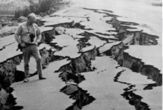Slow Slippage Could Predict Huge Earthquakes

Tiny tremors that are imperceptible at the Earth's surface and could foreshadow destructive mega earthquakes are generated by the slow slipping of tectonic plates deep inside of certain types of faults, a new study finds.
These weak seismic events, known as non-volcanic tremors and as low-frequency or silent earthquakes, are found primarily in subduction zones--a type of fault where one tectonic plates is continuously pushed under another. These faults are where some of the most destructive earthquakes have occurred, such as the 2004 Sumatra quake that triggered a devastating tsunami.
Such violent quakes, which occur every 100 to 600 years, originate at shallow depths in the fault. They are thought to be preceded by "silent" earthquakes that form much deeper in the fault and displace the ground without shaking it. These slower quakes can last for days, months or even years without ever being felt at the surface.
"In Japan, the deep section of the fault where slow earthquakes form is particularly significant, because it lies next to the shallower locked portion of the fault, where big quakes periodically strike," said Gregory Beroza of Stanford University, who worked on the study. "So each time a slow earthquake happens, it adds stress to the locked section and increases the likelihood of a magnitude 8 mega-thrust."
Fluids or slippage?
Though the connections between these two types of quakes had been made by seismologists, they were uncertain whether tremors were caused by fluids moving around deep in the subduction zone or the tectonic plates slipping past each other.
The new analysis, detailed in the March 15 issue of the journal Nature, compared seismographs from tremors and low-frequency earthquakes and found that they had similar signatures.
Get the world’s most fascinating discoveries delivered straight to your inbox.
"This demonstrates that the tremor is actually a swarm of hundreds of thousands of LFEs (low frequency earthquakes), each of which is caused by slip on the deep part of the fault--the same mechanism by which regular earthquakes are generated, but with a twist," Beroza said. "The slip in the deep tremor happens more slowly than in ordinary earthquakes."
Better prediction?
Monitoring these slow quakes could help predict larger quakes, because they occur before bigger quakes and add to the stress between the plates that causes them. But detecting these tremors is difficult and there isn't enough data to firmly establish the connection yet.
With a network of highly sensitive seismic instruments installed by the Japanese government a decade ago, scientists recently discovered that these slow earthquakes occur about every six months in a subduction zone near Shikoku, Japan.
They hope studying these tremors could help predict the next big earthquake in Shikoku, which could happen in less than 40 years, said David Shelley, lead author of the study. The last major earthquake to strike Shikoku, in 1946, was a magnitude 8.1 and killed more than 1,000 people.
Early last month, Canadian authorities announced a greater likelihood of an earthquake in the Cascadian subduction zone (which stretches from Northern California to British Columbia) based on tremor data. Fortunately, the quake has yet to happen.
- The Big Quake Quiz
- Mystery Vibrations Detected Inside Earth
- Silent Earthquakes Might Predict Major Events
- Images: Deadly Earthquakes
- All About Earthquakes

Andrea Thompson is an associate editor at Scientific American, where she covers sustainability, energy and the environment. Prior to that, she was a senior writer covering climate science at Climate Central and a reporter and editor at Live Science, where she primarily covered Earth science and the environment. She holds a graduate degree in science health and environmental reporting from New York University, as well as a bachelor of science and and masters of science in atmospheric chemistry from the Georgia Institute of Technology.


